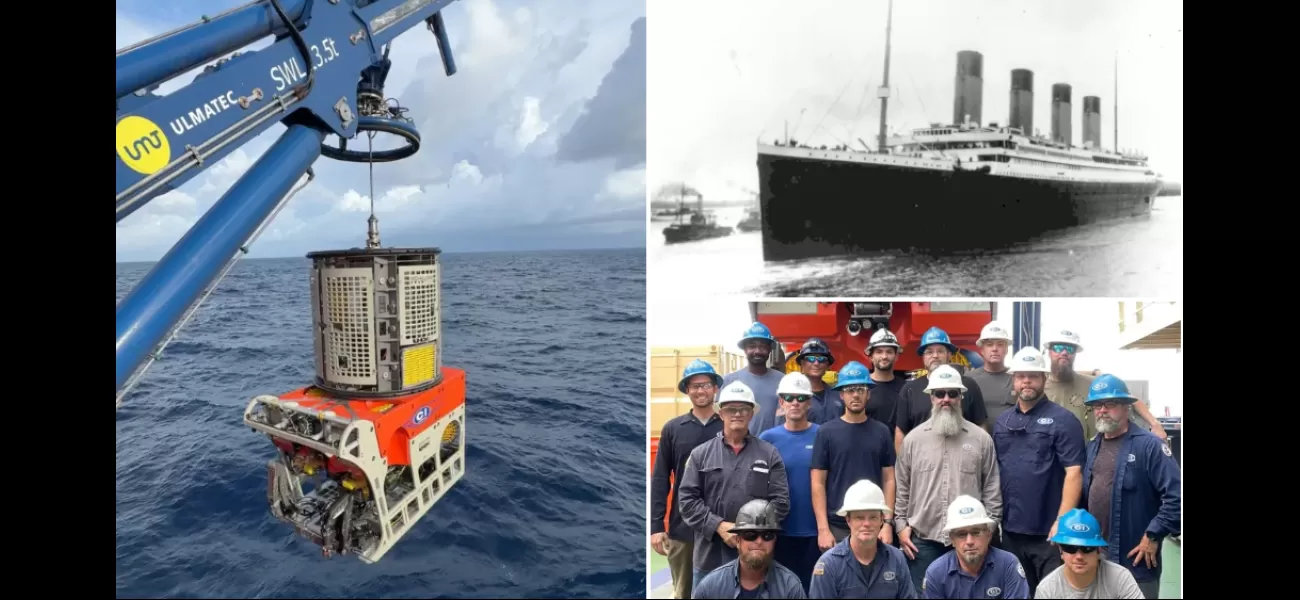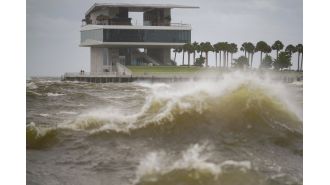A mission is exploring the Titanic wreck in 3D detail, venturing into the ocean's depths.
It will search below the ocean floor.
July 12th 2024.

A group of dedicated explorers are gearing up for an extraordinary journey back to the wreck of the Titanic. Their mission is to create a detailed map of the legendary ship and its surroundings, capturing never-before-seen images of the belongings that were scattered in the depths of the Atlantic ocean.
Using two six-tonne remotely-operated vehicles, the team from RMS Titanic Inc, the sole company with rights to salvage the ship, will embark on this ambitious 20-day operation. They have already collected over 5,500 objects from the wreckage, which lies 12,500 feet below the surface, but their current mission is to take things a step further.
Their ultimate goal is to create a highly detailed 3D photographic record of the Titanic, using millions of high-resolution photographs. In addition to this, they will also be using laser and magnetic scanners to gain new insights into the sinking of the ship.
The team's journey begins today, a little over a year after the tragic Titan disaster, where a submersible imploded on its descent to the wreck, claiming the lives of all five passengers. One of those passengers was Paul-Henri 'PH' Nargeolet, the director of research for RMS Titanic Inc.
Team member Rory Golden shared with the BBC that it is a difficult but necessary mission, driven by their passion for continuous exploration. Their hard work and perseverance are all in honor of PH's unwavering love for exploration.
As the Titanic was making its way from Southampton to New York, it collided with an iceberg and tragically sank on April 15, 1912. The ship split in two, with the bow resting on the seabed around 600 meters from the stern.
To document the Titanic in intricate detail, two ROVs will be deployed. While the remains of the ship have been somewhat documented, the debris field surrounding the wreck remains largely unexplored. But with the use of ultra-high-definition cameras, a special lighting system, and a lidar - light detection and ranging - laser scanner, the team aims to not only photograph the ship itself but also explore a one kilometer-squared section of the seafloor.
For the first time, a magnetometer will also be used in the vicinity of the wreckage. This instrument is capable of detecting metals and will provide new insights into the seabed.
The team is eager to uncover what lies beneath the surface, especially in and around the seabed. Geophysics engineer Alison Proctor expressed her excitement, stating that it would be a dream come true to determine the condition of the bow. She hopes to find out whether it was crushed upon impact or if it remains intact, buried in the sediment.
Evan Kovacs, the leader of the imaging program, added that if all goes according to plan, they will be able to capture the Titanic and its wreckage with unparalleled digital perfection. He even joked that they would be able to count grains of sand, but their main focus is not on the sand itself, but on what may be hidden within or on it.
The team has specific items in mind for investigation, such as an electric candelabra and a Steinway grand piano, both of which were reportedly spotted during previous visits. While the wood of the piano may have disintegrated, there is a chance that its metal insides and keys may still be visible.
RMS Titanic Inc's artefact curator shared that she is particularly interested in the passengers' belongings, such as their bags. She believes that these items help bring their stories to life and give more meaning to the names on the passenger list.
Visits to the Titanic have sparked controversy, with some arguing that the site where 1,517 people lost their lives should be left untouched. However, during this mission, the team will hold a memorial for those who perished, including the Titan's passengers. They will also lay a plaque in honor of Paul-Henri Nargeolet, fondly known as 'Mr. Titanic.'
James Penca, a researcher at RMS Titanic Inc, addressed the concerns about disturbing the wreck, assuring that they approach their dives with utmost respect for the historical significance of the site. He believes that leaving the passengers and crew lost to history would be a greater tragedy.
Using two six-tonne remotely-operated vehicles, the team from RMS Titanic Inc, the sole company with rights to salvage the ship, will embark on this ambitious 20-day operation. They have already collected over 5,500 objects from the wreckage, which lies 12,500 feet below the surface, but their current mission is to take things a step further.
Their ultimate goal is to create a highly detailed 3D photographic record of the Titanic, using millions of high-resolution photographs. In addition to this, they will also be using laser and magnetic scanners to gain new insights into the sinking of the ship.
The team's journey begins today, a little over a year after the tragic Titan disaster, where a submersible imploded on its descent to the wreck, claiming the lives of all five passengers. One of those passengers was Paul-Henri 'PH' Nargeolet, the director of research for RMS Titanic Inc.
Team member Rory Golden shared with the BBC that it is a difficult but necessary mission, driven by their passion for continuous exploration. Their hard work and perseverance are all in honor of PH's unwavering love for exploration.
As the Titanic was making its way from Southampton to New York, it collided with an iceberg and tragically sank on April 15, 1912. The ship split in two, with the bow resting on the seabed around 600 meters from the stern.
To document the Titanic in intricate detail, two ROVs will be deployed. While the remains of the ship have been somewhat documented, the debris field surrounding the wreck remains largely unexplored. But with the use of ultra-high-definition cameras, a special lighting system, and a lidar - light detection and ranging - laser scanner, the team aims to not only photograph the ship itself but also explore a one kilometer-squared section of the seafloor.
For the first time, a magnetometer will also be used in the vicinity of the wreckage. This instrument is capable of detecting metals and will provide new insights into the seabed.
The team is eager to uncover what lies beneath the surface, especially in and around the seabed. Geophysics engineer Alison Proctor expressed her excitement, stating that it would be a dream come true to determine the condition of the bow. She hopes to find out whether it was crushed upon impact or if it remains intact, buried in the sediment.
Evan Kovacs, the leader of the imaging program, added that if all goes according to plan, they will be able to capture the Titanic and its wreckage with unparalleled digital perfection. He even joked that they would be able to count grains of sand, but their main focus is not on the sand itself, but on what may be hidden within or on it.
The team has specific items in mind for investigation, such as an electric candelabra and a Steinway grand piano, both of which were reportedly spotted during previous visits. While the wood of the piano may have disintegrated, there is a chance that its metal insides and keys may still be visible.
RMS Titanic Inc's artefact curator shared that she is particularly interested in the passengers' belongings, such as their bags. She believes that these items help bring their stories to life and give more meaning to the names on the passenger list.
Visits to the Titanic have sparked controversy, with some arguing that the site where 1,517 people lost their lives should be left untouched. However, during this mission, the team will hold a memorial for those who perished, including the Titan's passengers. They will also lay a plaque in honor of Paul-Henri Nargeolet, fondly known as 'Mr. Titanic.'
James Penca, a researcher at RMS Titanic Inc, addressed the concerns about disturbing the wreck, assuring that they approach their dives with utmost respect for the historical significance of the site. He believes that leaving the passengers and crew lost to history would be a greater tragedy.
[This article has been trending online recently and has been generated with AI. Your feed is customized.]
[Generative AI is experimental.]
0
0
Submit Comment





